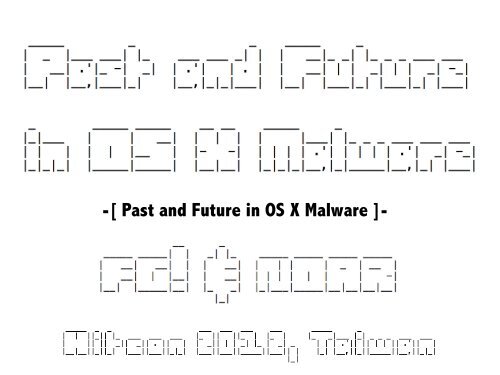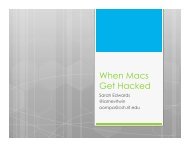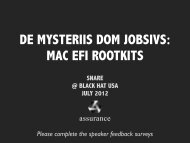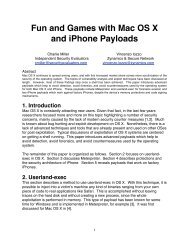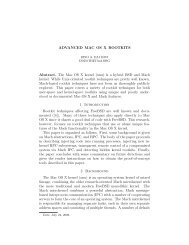here - Reverse Engineering Mac OS X - PUT.AS
here - Reverse Engineering Mac OS X - PUT.AS
here - Reverse Engineering Mac OS X - PUT.AS
Create successful ePaper yourself
Turn your PDF publications into a flip-book with our unique Google optimized e-Paper software.
-[ Past and Future in <strong>OS</strong> X Malware ]-
Who Am I§ An Economist and MBA.§ Computer enthusiast for the past 30 years.§ Someone who worked at one of the world’s best ATMnetworks, the Portuguese Multibanco.§ A natural-born reverser and assembler of all kinds ofthings, not just bits & bytes.
Who’s noar§ Self-taught researcher.§ Consultant / Insultant in security software.§ Former Apple BlackOps.§ Uses a <strong>Mac</strong> since AAPL was $12.§ Bought no shares at that time!§ Never pwned, although he dares to open my PowerPointfiles.
Objective§ Starting point: <strong>Mac</strong>s are immune to malware.§ Latest Flashback variants broke THE myth.§ In fact, it’s quite easy to write high quality <strong>OS</strong> X malware!§ That’s what I want to demonstrate today.
Summary§ <strong>OS</strong> X malware history.§ Flashback, the mythbuster.§ Code injection techniques.§ <strong>OS</strong>.X/Boubou – A PoC infector/virus.§ Privilege escalation.§ Final remarks.
History – From lamware to malwareHistory & glory are not made of:§ Backdoors written in REALBasic.§ Old IRC bots.§ Keyloggers that use Universal Access (logKext rulesthem all).§ PoCs (except mine!).
History – Lamware, 2006Oompa Loompa§ Spread via iChat Bonjour buddy list.§ Injection into Cocoa apps using Input Managers.§ Requires user interaction to execute it.
History – Lamware, 2006Opener 3.9§ Same old shell script as a startup item.§ The usual trojan horse toolbag:§ Hidden admin user (UID < 501), enable SSH, AFP, SMB.§ Data mining, hash cracking (JtR), logs cleaning.§ New features:§ Anti-Little Snitch prequel, anti-virus white-listing.§ Capture network traffic using dsniff.
History – Lamware, 2007RSPlug aka DNSChanger§ First fake codec package.§ Prepend DNS every minute using scutil and cron.§ Perl script to call home.§ Shell script, later obfuscated using … tr!§ Polymorphism?
History – Lamware, 2007
History – Lamware, 2007<strong>Mac</strong>Sweeper, later iMunizator§ First scareware.§ -(BOOL)[RegistrationManager isRegistered] and patcha few bytes…§ And it really works!§ Prequel of <strong>Mac</strong>Defender and company.
History – Lamware, 2008iWorkServices and company§ First malicious torrents?§ Yet another startup item.§ Contains LUA scripting!§ Used for DD<strong>OS</strong> attacks.
History – Lamware, 2008AppleScript trojan horse template§ Interesting features:§ Stay quiet if Little Snitch exists.§ Old school reverse shell using nc / cat.§ Script “in the middle” sudo.§ Different user levels (user, admin, root).§ Point antivirus update servers to localhost.§ t<strong>here</strong>_are_no_osx_viruses_silly_wabbit().
History – Lamware, Remarks§ The key features are <strong>here</strong>!§ Recent threats are “updates” of old features (ChuckNorris likes launchd).§ But implementation is always lame.§ Too generic to be harmful (took 3 years to Opener toimprove data mining).§ Easy to reverse (no encryption).§ Trick the user to get root: I can haz r00t, plz?
Now for something different…It’s…*Note: no connection whatsoever with flashback.net, I just like the picture!
History – Malware
History – Malware§ Some similarities with previous lamware:§ Fake codec package.§ Different user levels (user, root).§ Stay quiet if some applications exist: Little Snitch,VirusBarrier, Xcode, etc.§ In later versions uses launchd.
History – Malware§ Yet, so different and new:§ Real hijacked websites.§ Infect only once (persistent cookies, IP, UUID).§ Polymorphic (so many binaries).§ Interposers.§ Later, used exploits CVE-2008-5353, CVE-2012-0507.§ And became that famous 600k botnet.
Flashback Tricks
Flashback Tricks – #1§ From the old trick: ~/.<strong>Mac</strong><strong>OS</strong>X/environment.plist (http://rixstep.com/2/20070201,00.shtml).§ To the new trick: interpose (hooking, function hijacking).§ DYLD_INSERT_LIBRARIES is the real thing!§ Tracks user requests by hooking a few functions.§ _hook_CFReadStreamRead, _hook_CFWriteStreamWrite.§ Not perfect, crashed some apps (Skype, FCP, etc).
Flashback Tricks – #1
Flashback Tricks - # 2§ Playing Robin Wood with Google since day 1.§ Not just in the latest versions as implied by some AVblog posts.
Flashback Tricks - # 2
Flashback Tricks - # 2
Flashback Tricks - #3§ And also tweeting from day 1!
Flashback Tricks - #4§ Polymorphism?§ Absolute path of Preferences.dylib.§ Sends SHA1 of Preferences.dylib to C&C server.§ On latest releases, data was XORed with machine UUID.
Flashback Tricks - #4
Flashback Tricks - #4
Flashback Tricks - #4
Flashback Tricks - #4
Flashback - Remarks§ Flashback put <strong>Mac</strong> Malware a step further.§ It’s a reality, not a myth.§ Some unsolved “puzzle” pieces:§ Do personalized variants exist?§ Does a rootkit exist?§ T<strong>here</strong> are suspicious references to sysent!
My Tricks
Code Injection§ As we saw, latest versions of Flashback useDYLD_INSERT_LIBRARIES trick.§ It’s the easiest method.§ But it’s also too noisy and easy to detect.§ And more important, easy to clean up.
Code Injection§ We can use the same library injection idea.§ But stealthier and targeted.§ The trick is to add a new library command into <strong>Mac</strong>h-Oheaders.§ More specifically, a LC_LOAD_DYLIB command.§ The linker will happily load our code into the process.§ Usually, t<strong>here</strong>’s enough header space to do it.
Code InjectionSome stats from our /Applications folder:Version Average Size Min Max32bits 3013 28 4917664bits 2601 32 36200Minimum required size is 24bytes.Check http://reverse.put.as/2012/01/31/antidebug-trick-1-abusing-mach-o-to-crash-gdb/for a complete description.
Code Injection – How to do it§ Find the position of last segment command.§ Find the first data position, it’s either __text section orLC_ENCRYPTION_INFO (i<strong>OS</strong>).§ Calculate available space between the two.§ Add new command (if enough space available).§ Fix the header: size & nr of commands fields.§ Write or overwrite the new binary.
Code Injection – How to do it
Code Injection – Other possibilities§ Exploiting four other possibilities to inject code into thebinary.§ The first one is the slack space between __TEXT and__DATA?§ Unfortunately for us, t<strong>here</strong>’s not enough space.§ Besides a few exceptions, Skype for example.§ The ELF Virus Writing HOWTO discusses this.§ It’s a known “hole” and patched in GCC.
Code Injection – Other possibilities90807060Free space between TEXT and DATA segments Count 5040302032bits 64bits 1000 1 2 3 4 7 8 11 12 16 17 18 20 23 24 28 32 48Free bytes
Code Injection – Other possibilities§ The second is to try to inject a new section into __TEXT.§ Doesn’t work!§ <strong>Mac</strong>h-O loader does not respect section data.§ Only the segment info.§ Check http://reverse.put.as/2012/02/02/antidisassembly-obfuscation-1-apple-doesnt-follow-theirown-mach-o-specifications/for a better description.
Code Injection – Other possibilities
Code Injection – Other possibilities
Code Injection – Other possibilities§ Third possibility: the functions alignment NOP space.§ We are interested in the long NOP sequences.§ They have enough space to execute two instructions.§ First instruction does an operation, the second jumps tothe next available space.§ Is t<strong>here</strong> enough space to attempt this?
Code Injection – Other possibilitiesBBEditNOP Size Count Total available bytes1 170619 1706192 404 8083 361 10834 336 13445 742 37106 1808 108487 1927 134898 737 58969 359 323110 395 3950Total bytes 214978AdiumNOP Size Count Total available bytes1 225 2252 12 243 20 604 6 245 42 2106 5 307 28 1968 9 729 3 2710 9 9011 9 9912 3 3613 14 18214 2 2815 6 90Total bytes 1393
Code Injection – Other possibilities§ Highly variable between versions, newer BBEdit has adifferent profile.§ Requires “complex” shellcode payload.§ A mix of operations and jumps.§ And jumps only, to reach the usable areas.§ Needs to solve some symbols.§ And execute a 2nd stage payload.§ Non-exec heap from Lion onwards.
Code Injection – Other possibilities§ Fourth possibility.§ Add a new segment command.§ With execution permissions.§ And modify entrypoint or its code to start executionfrom t<strong>here</strong>.§ We could reorder the segments to make this less visible.§ A LC_SEGMENT at the end is highly suspicious.
<strong>OS</strong>.X/Boubou
<strong>OS</strong>.X/Boubou§ A <strong>OS</strong> X proof of concept infector/virus.§ Tries to infect /Applications.§ Two stages infection:1) Apps owned by the current user.2) Remaining apps (root owned) if privilege escalationis successful.
<strong>OS</strong>.X/Boubou§ Uses the library injection technique to infect the mainbinary.§ Also supports frameworks.§ Two main components:– The infector - responsible for infection.– The library - contains the malware payload.
<strong>OS</strong>.X/Boubou§ Tries to make life harder for anti-virus.§ Steals a random amount of bytes from the infectedbinary code.§ Encrypts and stores them at the library.§ One library per infected binary/framework.§ Clean-up requires more work J.
<strong>OS</strong>.X/Boubou§ Does not use Launch Daemons or Services.§ That’s lame, seriously!§ Many apps are infected, so t<strong>here</strong>’s a strong probabilityof having our malware payload frequently loaded.§ IM & Twitter clients, for example.§ The backdoor availability should be equivalent to adaemon.
<strong>OS</strong>.X/Boubou§ We can try to escalate privileges.§ Our malware payload is executed in app context.§ Try to exploit the human element - abuse trust andfamiliarity.§ Use authorization services framework to request higherprivileges.§ Flashback does it but from a terminal program.§ This is unusual and more suspicious.
<strong>OS</strong>.X/Boubou
<strong>OS</strong>.X/Boubou§ This app context property is also useful to “attack” LittleSnitch and other app firewalls.§ The connection request starts from a “trusted”application.§ Strong probability of user accepting connections.§ Or we can be smarter!§ Parse Little Snitch rules looking for suitable rules (any/any?).
<strong>OS</strong>.X/Boubou – How it works§ The infector searches for available frameworks insideeach app and randomly selects one.§ Verifies if it’s infectable and if not goes to the next one.§ If all previous attempts fail it tries to infect main binary.§ Steals a random number of bytes from the __textsection and stores them inside the library.§ This is done by expanding the __LINKEDIT segment (orwith a new segment, if we wish so).
<strong>OS</strong>.X/Boubou – How it works§ The library has a constructor as its entrypoint.§ extern void init(void) __attribute__ ((constructor));§ When the app is started, dyld will load the infectedlibrary and call the constructor.§ Next step is to find its own address (<strong>AS</strong>LR compatible)and the image it stole the bytes from.§ Verifies if target was a framework or executable.§ Decrypts the stored bytes.
<strong>OS</strong>.X/Boubou – How it works§ And restores them.§ Infected application can now run normally.§ We can launch a thread with our malware payload.§ A botnet with C&C.§ Or just hijack the browser(s) as Flashback did.§ Or log the IM messages.§ Or steal iTunes logins and CC info (http://reverse.put.as/2011/11/22/evil-itunes-plugins-from-hell/).§ Or some other (evil) stuff!
<strong>OS</strong>.X/Boubou – How it works
<strong>OS</strong>.X/Boubou – “APT”§ It isn't fun if you can’t keep it!§ App updates will kill the infection L.§ But the probability of losing total access is very low.§ Because we infected so many apps.§ We can do better!§ Let’s continue to abuse features and probabilities…
<strong>OS</strong>.X/Boubou – “APT”§ Sparkle framework (http://sparkle.andymatuschak.org/).§ “Sparkle is an easy-to-use software update frameworkfor Cocoa developers.”.§ Each app has its own framework copy.§ We can hijack/swizzle the update process.§ And infect again the updated version.§ Oh, and while we are t<strong>here</strong> we can escalate privileges:ask user password to upgrade.
<strong>OS</strong>.X/Boubou – “APT”§ Other ways to keep access:§ Check snare’s awesome work on EFI rootkits.§ Install a TrustedBSD rootkit. (http://reverse.put.as/2011/09/18/abusing-os-xtrustedbsd-framework-to-install-r00t-backdoors/)§ Patch the anti-virus. (http://reverse.put.as/2012/02/13/av-monster-themonster-that-loves-yummy-os-x-anti-virus-software/)§ Classic sysent rootkit or any other type.§ Etc...
<strong>OS</strong>.X/Boubou – AV-Monster§ This is a PoC I created a couple of months ago.§ Abuses the fact that t<strong>here</strong> is a single point of entry forAV products (check Apple Note 2127).§ AVs kernel module installs a listener that receives fileevents and pass this info to the userland scanningengine.§ We can patch the listener.§ And it’s game over!
}return result;<strong>OS</strong>.X/Boubou – AV-MonsterNote: Kauth is not invoked when a program is started by the debugger. You can detect this case using the techniqueshown in Technical Q&A QA1361, 'Detecting the Debugger'.Back to TopAnti-Virus ScannerKauth allows you to implement an anti-virus program that supports both "on access" and "post modification" file scanning.The latter is easy: all you need to do is register a listener for the KAUTH_SCOPE_FILEOP scope and watch for theKAUTH_FILEOP_CL<strong>OS</strong>E action. If you see a modified file being closed, you can pass that file to your user space daemon forscanning. As the scanning proceeds asynchronously in the background, t<strong>here</strong> should be no problems with deadlock.Implementing "on access" scanning is more challenging. Your approach depends on whether you can always fix a file. Ifthat's the case, you can listen for KAUTH_FILEOP_OPEN (in the KAUTH_SCOPE_FILEOP) and scan the file immediately after it's beenopened. However, the result of your listener is always ignored, so t<strong>here</strong> is no way to deny the actor access to that file.If you can't always fix a file, and thus you may want to deny the actor access to the file, you must listen for the appropriateactions in the KAUTH_SCOPE_VNODE scope. If you scan a file, detect that it's infected, and can't fix it, you should returnKAUTH_RESULT_DENY to prevent the actor from using it.The difficulty with both of these "on access" approaches is avoiding deadlock. See Implementing a Listener for a detaileddiscussion of this problem.Back to TopNew Kernel SubsystemIf you're implementing an entirely new kernel subsystem (for example, a sophisticated protocol stack), you may decide toimplement your authorization using Kauth. T<strong>here</strong> are seven steps to this:1.Decide on a scope name. You should use a reverse DNS-style name, as illustrated by the built-in scopes described inthis document.
<strong>OS</strong>.X/Boubou – AV-Monster§ Patches the in-memory kernel module.§ The disk version can be easily patched.§ At the time of testing no AV had checksum features.§ As far as I know it still holds true today.§ Argument: if you gain root, all is lost.§ It’s valid and somewhat reasonable!§ But, how really hard is to gain root access?
Privilege escalation§ This presentation assumes that t<strong>here</strong>’s a way to executethe malware code.§ I’m not much of a exploitation guy.§ And assumptions are the economist’s trick to simplify hisjob J.§ <strong>OS</strong> X is less audited so it should be easier to find holes.§ But... <strong>here</strong> is a simple, widespread, lame(!) and still notfixed way to do it.
Privilege escalation – A ½ dayz§ Apps delegate privileged operations in helper binaries.§ These binaries can be overwritten due to badpermissions.§ Because many applications are installed with drag &drop.§ Permissions = logged-in user.§ Overwrite one of the helpers with a simple shell script ora binary of your choice.
Privilege escalation – A ½ dayz§ Backup applications.§ Require higher privileges to make full backups.§ Overwrite one helper binary.§ Wait for a backup and voilà, exploit code is executed withhigher privileges.§ Infect the whole system, install your r00tkitz, etc.§ Win!
Privilege escalation – A ½ dayz§ Carbon Copy Cloner
Privilege escalation – A ½ dayz
Privilege escalation – A ½ dayz
Final remarks§ It’s not really hard to write “good” <strong>OS</strong> X malware.§ The (monetary) incentives exist and are increasing.§ Number of samples will grow.§ Maybe more targeted attacks - Execs love <strong>Mac</strong>s!§ Gatekeeper is an interesting move.§ But identity theft is not rocket science.§ And infection rates could be huge before t<strong>here</strong>’s time tocancel the certificate.
Final remarks – Solutions?§ Throwing (more) money at the problem doesn’t work.§ Reduce the incentives!§ Not with long-term prison threats.§ With education.§ I don’t believe that making users dumb and leavingeverything to technology is the solution.§ We need to make users smart and aware, not dumb andpassive.
References§ http://reverse.put.as§ http://ho.ax§ Eric Filiol and J.-P. Fizaine. "Max <strong>OS</strong> X n'est pas invulnérable auxvirus : comment un virus se fait compagnon". Linux Magazine HS32.§ http://www.securelist.com/en/analysis/204792227/The_anatomy_of_Flashfake_Part_1§ http://www.intego.com/mac-security-blog/§ http://www.symantec.com/connect/ko/blogs/osxflashbackkoverview-and-its-inner-workings§ <strong>Mac</strong> <strong>OS</strong> X ABI <strong>Mac</strong>h-O File Format Reference
Greets to:snare, #osxre, Od, put.as team, nullm0demOld sk00l greets to:nemo, LMH, KF, mu-b, Dino Dai Zovi, CharlieMiller, Carsten Maartmann-MoeAnd a special thanks to noar, for hiscontribution, valuable feedback and ideasJ
http://reverse.put.ashttp://github.com/gdbinitreverser@put.as@osxreverser#osxre @ irc.freenode.net


